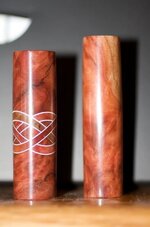ngeb528
Member
Hi all,
I'm getting ready to start trying segmenting (got to go to the next level) and have a question but also would like any advice you may have.
My question is this: I often see a thin metal band around segmented areas on many of the pics posted around here. What is that made from? I think some are silver and others look gold in color. What are you using?
Thanks for any answers and any advice you can give someone just getting ready to try this technique.
Nancy
I'm getting ready to start trying segmenting (got to go to the next level) and have a question but also would like any advice you may have.
My question is this: I often see a thin metal band around segmented areas on many of the pics posted around here. What is that made from? I think some are silver and others look gold in color. What are you using?
Thanks for any answers and any advice you can give someone just getting ready to try this technique.
Nancy

